
 |
Tea Clipper |
 |
| from TeaAntiques.com | ||
| Edition One Hundred and Seven |
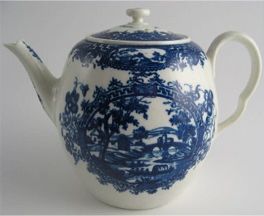
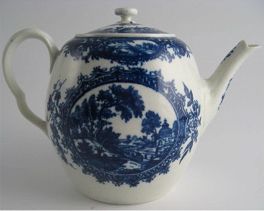 A
rare and beautiful Worcester teapot and cover with a smooth barrel-shaped body,
decorated in blue and white with prints of 'European Landscapes' within an oval
wreath framework, c1785-90. This stunning Worcester teapot is from the 'Godden Reference
Collection'.
A
rare and beautiful Worcester teapot and cover with a smooth barrel-shaped body,
decorated in blue and white with prints of 'European Landscapes' within an oval
wreath framework, c1785-90. This stunning Worcester teapot is from the 'Godden Reference
Collection'.
The teapot is decorated on both sides with 'European landscapes'. The two landscapes are each different and are delightfully framed by a wreath of oriental type of rococo decoration. On the left side of the teapot, the landscape decoration shows a scene that includes buildings, a double span bridge and a boat on the river, bounded by hills and trees. The decoration on the right hand side of the teapot shows a European landscape that includes a church, with a cross on the tower. A person is by the fields which have little hay sheaves standing within it. There is a man fishing in the river to the lower right and two windmills in the distance; again the landscape has hills and trees.
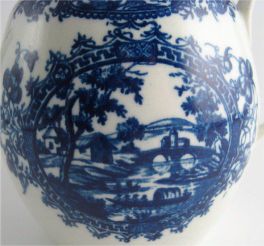
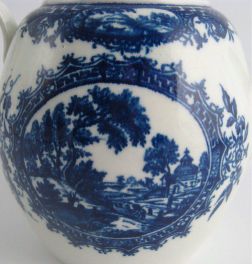
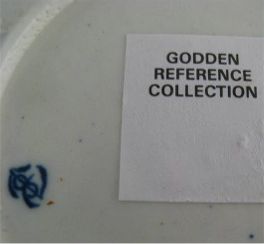
The underside of the teapot is marked with a blue disguised numeral mark, in this case an '8'. These marks were used at the famous Worcester factory to imitate Chinese marks and were used between c1775-90. There is also a paper label on the base of the teapot and underside of the cover which states 'Godden Reference Collection.
A very fine early Worcester teapot for the collector of Worcester tea wares.
More details of this item and other tea related antiques can be found by visiting my web site at www.TeaAntiques.com.
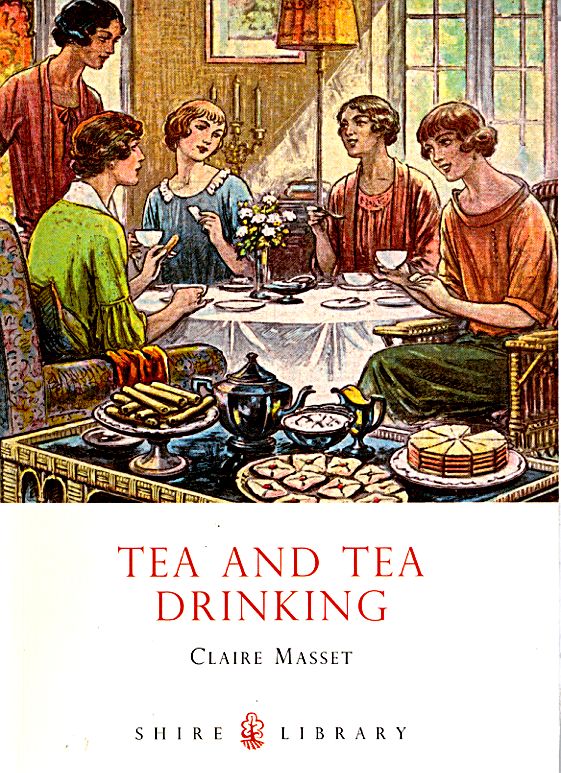 by
Claire Masset
by
Claire Masset
published by Shire Library
56 pages
Paperback
This fascinating book explores the evolution of tea drinking over the past 350 years, showing how it has infused every level of British life.
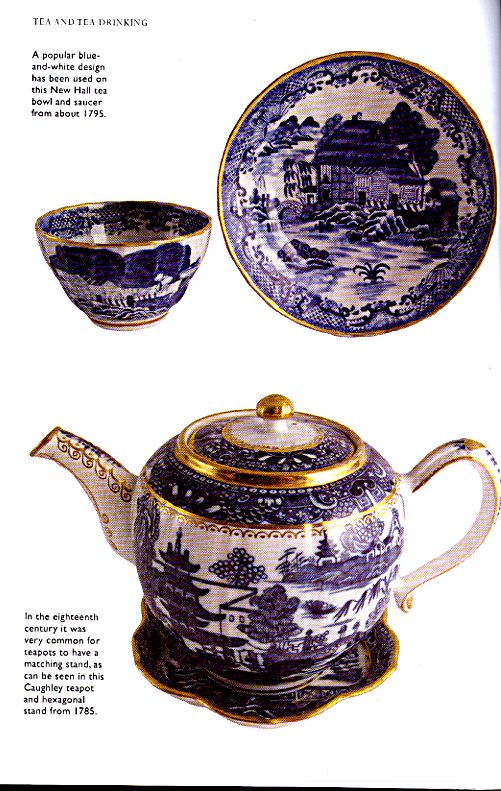 It
is difficult to imagine life without tea, yet there was a time when it was so expensive
that only the extremely wealthy could afford it. The drink and its culture have
changed dramatically since Samuel Pepys drank the first recorded cup of tea in 1660.
Initially, it was drunk by men in coffee houses and by women in the home, until
gradually afternoon teas and tea parties became fashionable and then tea became
an integral part of life for people of all classes. But what about high tea and
tea dances? Who visited the tea rooms and tea gardens? And who wore tea gowns? This
fascinating book answers these questions and explores the evolution of tea drinking
over the past 350 years, showing how it has infused every level of British life.
It
is difficult to imagine life without tea, yet there was a time when it was so expensive
that only the extremely wealthy could afford it. The drink and its culture have
changed dramatically since Samuel Pepys drank the first recorded cup of tea in 1660.
Initially, it was drunk by men in coffee houses and by women in the home, until
gradually afternoon teas and tea parties became fashionable and then tea became
an integral part of life for people of all classes. But what about high tea and
tea dances? Who visited the tea rooms and tea gardens? And who wore tea gowns? This
fascinating book answers these questions and explores the evolution of tea drinking
over the past 350 years, showing how it has infused every level of British life.
Claire Masset is a writer and editor specialising in social history, art, architecture and gardens. She has an MA in Art History, an M.Phil in Decorative Arts and a Postgraduate Certificate in Architectural History. She writes for Heritage magazine and many other publications.
TeaAntiques.com provided some of the images used in the book; one page of which is shown on the right.
As the festive season approaches, there are many interesting things to see and do as well as the usual Christmas shopping! One thing that I did last year, and I can recommend as a really fantastic family day out, is to visit Hampton Court Palace between Christmas and the New year, when they host their Christmas celebrations from the past.
Hampton Court is best known as the Great Tudor Palace built by King Henry VIII. Much of the old Tudor Palace, particularly the kitchen blocks still remain and escaped the complete destruction of the Tudor Palace by King William and Queen Mary when they were to build a more up to date Palace in its place. Fortunately (for Tudor history), they ran out of money and so their entire dream Palace was never completed and so some of the Tudor Palace remains.
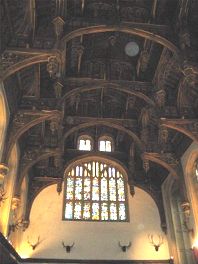
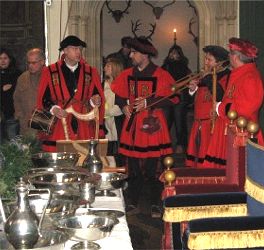 During
this Christmas and New year period in 2009, Hampton Court hosted a 'Tudor Christmas'.
As well as the usual attractions to be seen within the Palace, Play actors were
there to bring the Tudor Palace to life with little enactments of what the King's
life at Hampton Court may have been like during the Christmas period. In the Great
Hall, built by Henry VIII, with its magnificent stained glass windows and huge hammer
beam roof, I went to see one such enactment. This scene was set with King Henry
VIII and one of his six wives to enter the Great Hall to receive his subjects and
to be presented with some gifts. The proceedings began with scarlet clothed musicians
there to play music to welcome the Royal hosts. The cloths and instruments played
are exact copies of the period. A few of the pieces played were composed by King
Henry VIII himself as he was an accomplished composer and liked to play music himself.
During
this Christmas and New year period in 2009, Hampton Court hosted a 'Tudor Christmas'.
As well as the usual attractions to be seen within the Palace, Play actors were
there to bring the Tudor Palace to life with little enactments of what the King's
life at Hampton Court may have been like during the Christmas period. In the Great
Hall, built by Henry VIII, with its magnificent stained glass windows and huge hammer
beam roof, I went to see one such enactment. This scene was set with King Henry
VIII and one of his six wives to enter the Great Hall to receive his subjects and
to be presented with some gifts. The proceedings began with scarlet clothed musicians
there to play music to welcome the Royal hosts. The cloths and instruments played
are exact copies of the period. A few of the pieces played were composed by King
Henry VIII himself as he was an accomplished composer and liked to play music himself.
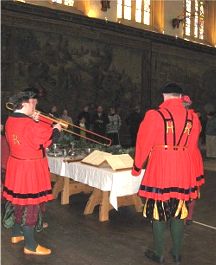
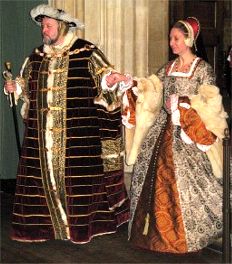 As
the musicians struck up, so the King entered the Great Hall with the Queen on his
hand. The King and Queen were magnificently attired in Royal regalia and commanded
instant respect and majesty from the gathered members of the public - some of the
young children looked a little awe-struck, if not a little frightened at the presence
of such a noble and larger than life figure. A few of the young children had been
given a short lesson on how to approach the king; never to turn one's back, to bow
or curtsey a number of times as you approach and leave the King. Also, not to speak
until you are spoken too and to remain in a position down on one knee in front of
the King until he orders you to rise. The nervous children approached the King with
their gifts - not always well received by him - a frightening experience!
As
the musicians struck up, so the King entered the Great Hall with the Queen on his
hand. The King and Queen were magnificently attired in Royal regalia and commanded
instant respect and majesty from the gathered members of the public - some of the
young children looked a little awe-struck, if not a little frightened at the presence
of such a noble and larger than life figure. A few of the young children had been
given a short lesson on how to approach the king; never to turn one's back, to bow
or curtsey a number of times as you approach and leave the King. Also, not to speak
until you are spoken too and to remain in a position down on one knee in front of
the King until he orders you to rise. The nervous children approached the King with
their gifts - not always well received by him - a frightening experience!
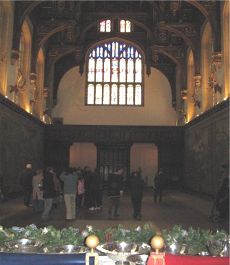
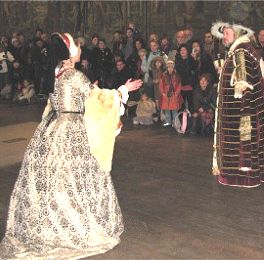
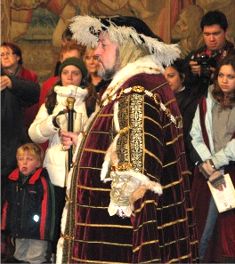
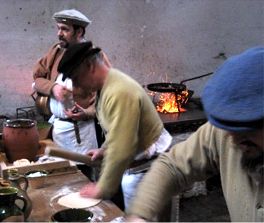
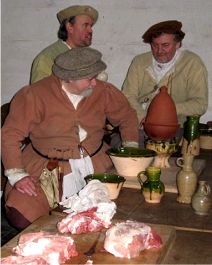 Within
the Tudor kitchens, situated in a separate block below comprising a whole village
of separate rooms with specific food storage and preparation tasks, is being prepared
a Tudor feast. In the Great Kitchen there are teams of historian cooks, dressed
in Tudor costume, demonstrating how a Tudor feast was prepared and of what it would
have comprised.
Within
the Tudor kitchens, situated in a separate block below comprising a whole village
of separate rooms with specific food storage and preparation tasks, is being prepared
a Tudor feast. In the Great Kitchen there are teams of historian cooks, dressed
in Tudor costume, demonstrating how a Tudor feast was prepared and of what it would
have comprised.
A huge open log fire burns away in the cooking hearth with a spit being turned on which are large joints of beef slowly cooking to perfection. In other areas of the kitchen, men prepare the meat for cooking and the decorative embellishments, such as a wax crown to top off some of the extravagant food, suitably dressed in the dressing room before appearing on the King's table. Only men worked in the King's kitchens, a sign of wealth because men's wages were so much higher than those of women.
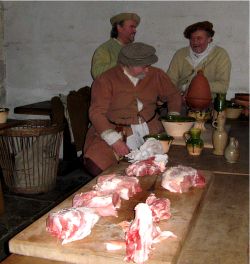
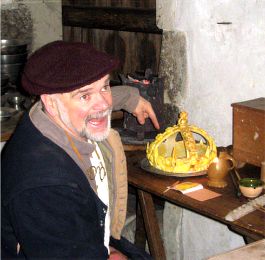
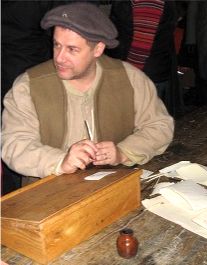
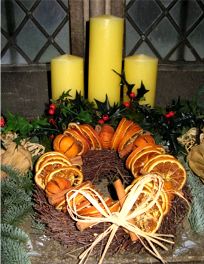 As
well as the preparation of food for the banquet, there are other items of interest
being demonstrated, such as how to make a quill pen. One thing I learned was that
quill pens did not have the feather part on the quill only a short stub of the quill
like a short pencil. the reason was that if you left the feather on the quill, it
would affect the balance of the pen and create drag when writing. The demonstration
showed how to cut the nib to give a good pen for writing. Such quills would have
been used within the kitchens to keep accounts of the stores and provisions, etc.
As
well as the preparation of food for the banquet, there are other items of interest
being demonstrated, such as how to make a quill pen. One thing I learned was that
quill pens did not have the feather part on the quill only a short stub of the quill
like a short pencil. the reason was that if you left the feather on the quill, it
would affect the balance of the pen and create drag when writing. The demonstration
showed how to cut the nib to give a good pen for writing. Such quills would have
been used within the kitchens to keep accounts of the stores and provisions, etc.
When you have had your fill of Tudor Christmas, then take a turn round the rest of the historic Palace, some of which is decorated beautifully for Christmas with large Christmas trees, standard holly trees that have been decorated and much greenery with candles, cones, ribbons and cinnamon sticks.
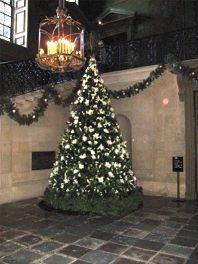
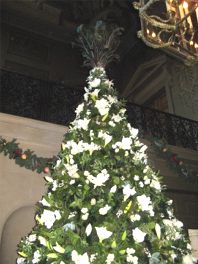 In
the great staircase to The Queen's apartments (these apartments were designed by
William and Mary, but Mary died before they were completed and were subsequently
completed by Queen Anne), stands a tall Christmas tree, decorated in white and topped
by Peacock feathers, a Royal symbol.
In
the great staircase to The Queen's apartments (these apartments were designed by
William and Mary, but Mary died before they were completed and were subsequently
completed by Queen Anne), stands a tall Christmas tree, decorated in white and topped
by Peacock feathers, a Royal symbol.
Inside the Queen's apartments are a succession of grand rooms containing thrones below rich canopies, beds, tapestries chandeliers and fine Delft pottery vases. After Queen Mary, these apartments were used by King George II and Queen Caroline. George II and his Queen liked Hampton Court and made a series of Georgian changes to the Palace including an apartment comprising series of Georgian rooms, many of which run along the back of the Queen's apartments.
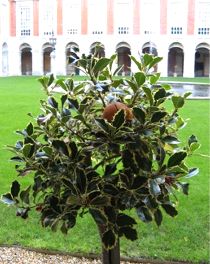
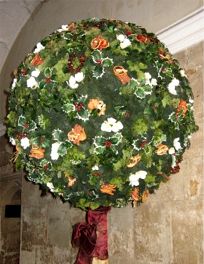
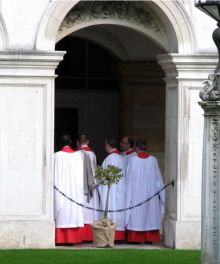
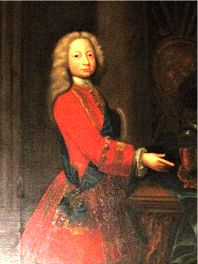
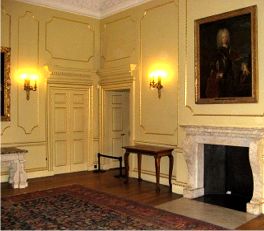 The
Georgian apartments include a separate apartment built for the King's second son,
William, Duke of Cumberland to the design of William Kent. The rooms in this suite
have a restrained and classically Georgian appearance. A series of long galleries
separate the suite of rooms designed for Queen Caroline.
The
Georgian apartments include a separate apartment built for the King's second son,
William, Duke of Cumberland to the design of William Kent. The rooms in this suite
have a restrained and classically Georgian appearance. A series of long galleries
separate the suite of rooms designed for Queen Caroline.
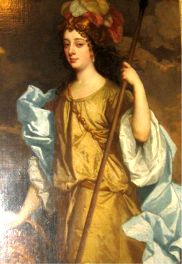
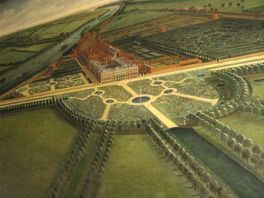 On
the way though these galleries are a few paintings to note. Firstly a pair of portraits
showing King George II and Queen Caroline in their Royal regalia and a portrait
of the Duchess of Cleveland, on which it is said 'Britannia' for UK coins was based.
There is also a magnificent painting showing an aerial view of the William and Mary
Palace with its beautiful formally laid out gardens.
On
the way though these galleries are a few paintings to note. Firstly a pair of portraits
showing King George II and Queen Caroline in their Royal regalia and a portrait
of the Duchess of Cleveland, on which it is said 'Britannia' for UK coins was based.
There is also a magnificent painting showing an aerial view of the William and Mary
Palace with its beautiful formally laid out gardens.
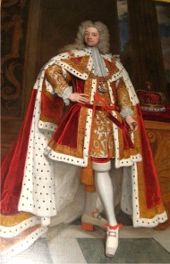
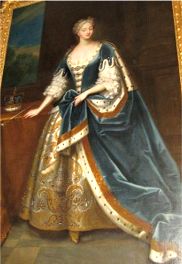
The last of the Galleries is known as the Cartoon Gallery, as it houses a set of Cartoons, painting produced from which copies could be made in tapestry. One of these cartoons actually has the tapestry copied from the painting hanging in the state rooms behind this gallery. Note that the tapestry is in reverse to the painting as the people weaving it worked from the back of the tapestry when copying the painting.
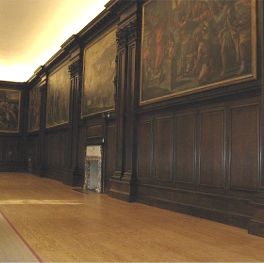
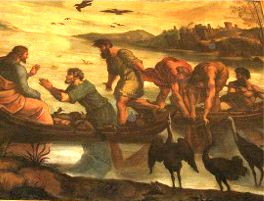
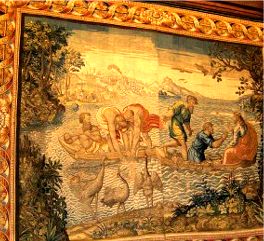
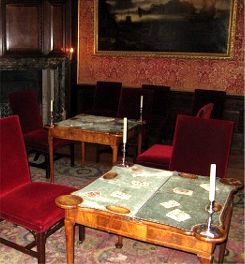
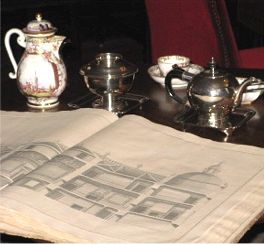 The
first of the more intimate Georgian rooms is known as the King George II's Private
Chamber. This warm and charming room decorated in a rich red wall fabric is furnished
with a very fine pair of games tables, each with their guinea wells and candle stands
on each corner. A tripod table stands in the room on which are a George II silver
'bullet' shaped teapot on stand along with some Continental porcelain from the eighteenth
century. A book is open on the desk which has plans made by Kent for changes to
the Palace. It is here where William Kent would have discussed his design ideas
with the King.
The
first of the more intimate Georgian rooms is known as the King George II's Private
Chamber. This warm and charming room decorated in a rich red wall fabric is furnished
with a very fine pair of games tables, each with their guinea wells and candle stands
on each corner. A tripod table stands in the room on which are a George II silver
'bullet' shaped teapot on stand along with some Continental porcelain from the eighteenth
century. A book is open on the desk which has plans made by Kent for changes to
the Palace. It is here where William Kent would have discussed his design ideas
with the King.
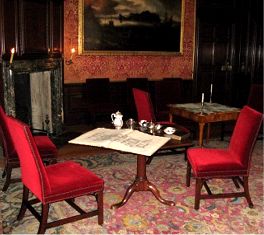
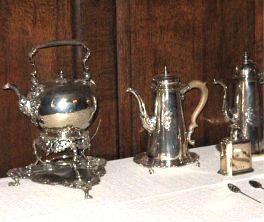 On
a side table within the Private Chamber stands a beautiful collection of period
silverware. There is an elegant spirit kettle on stand, tea canister, coffee and
chocolate pot as well as a mote spoon and set of teaspoons. All of great interest
to the collectors of George II tea silver. It is also worth noting the curious wooden
implement to the right of the spoons, this is the stirrer for the chocolate when
in the chocolate pot.
On
a side table within the Private Chamber stands a beautiful collection of period
silverware. There is an elegant spirit kettle on stand, tea canister, coffee and
chocolate pot as well as a mote spoon and set of teaspoons. All of great interest
to the collectors of George II tea silver. It is also worth noting the curious wooden
implement to the right of the spoons, this is the stirrer for the chocolate when
in the chocolate pot.
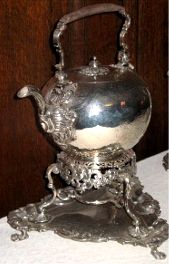
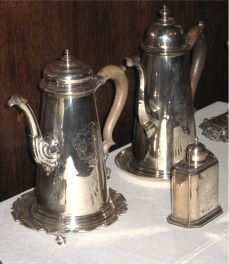
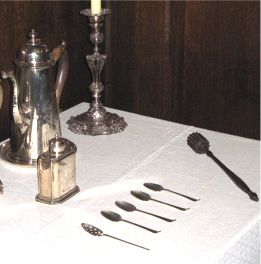
The Queen's bedroom is next, a vast bed covered in gold material dominates the room. Above the fireplace is a circular portrait of the Queen. Often the King would visit the Queen in her bedroom, as it was a more private place to be, than in his apartment.
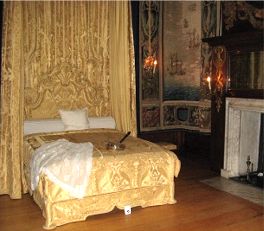
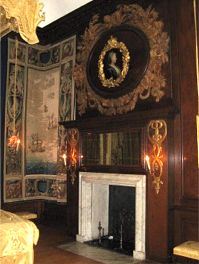
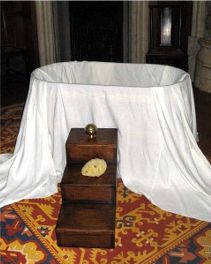
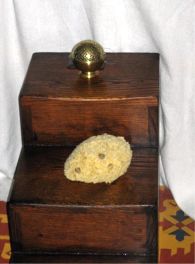 The
Queen insisted on bathing and bade the King and other members of her family to do
so. This was extremely unusual at this period, when to bath was considered bad for
the health. The Queen had her own wooden bath set up in her Closet. The bath was
lined with linen to prevent her getting splinters from the wood, as well as make
it slightly warmer for her. Steps were used to gain access to the bath.
The
Queen insisted on bathing and bade the King and other members of her family to do
so. This was extremely unusual at this period, when to bath was considered bad for
the health. The Queen had her own wooden bath set up in her Closet. The bath was
lined with linen to prevent her getting splinters from the wood, as well as make
it slightly warmer for her. Steps were used to gain access to the bath.
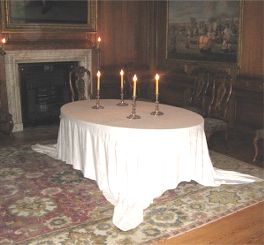
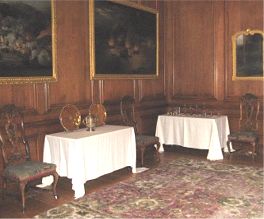 The
Queen had her own Private Dining Room. Here she would often dine alone, or maybe
on occasion, with the King. Public dining was carried out in a dining room within
the state apartments. On display are some very fine Eighteenth century English wine
glasses, decanters and green onion shaped bottles for the wine.
The
Queen had her own Private Dining Room. Here she would often dine alone, or maybe
on occasion, with the King. Public dining was carried out in a dining room within
the state apartments. On display are some very fine Eighteenth century English wine
glasses, decanters and green onion shaped bottles for the wine.
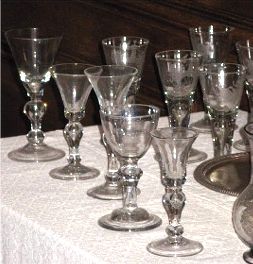
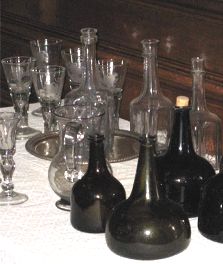
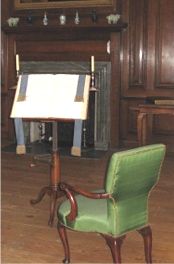 The
last of the rooms in this series of Georgian rooms is the Queen's Private Chapel.
Here the Queen could study the bible and pray in Private.
The
last of the rooms in this series of Georgian rooms is the Queen's Private Chapel.
Here the Queen could study the bible and pray in Private.
There is much more to be seen within Hampton Court Palace and its magnificent gardens. I hope this has given you a little taste of a Tudor Christmas and the beauty of Hampton Court Palace.
Hampton Court Palace
East Molesey
Surrey
KT8 9AU
Merry Christmas Tea Clipper Readers

From Adrian
To review past newsletters, just follow this link:
Past newsletters.
To subscribe to this free newsletter -
Click here